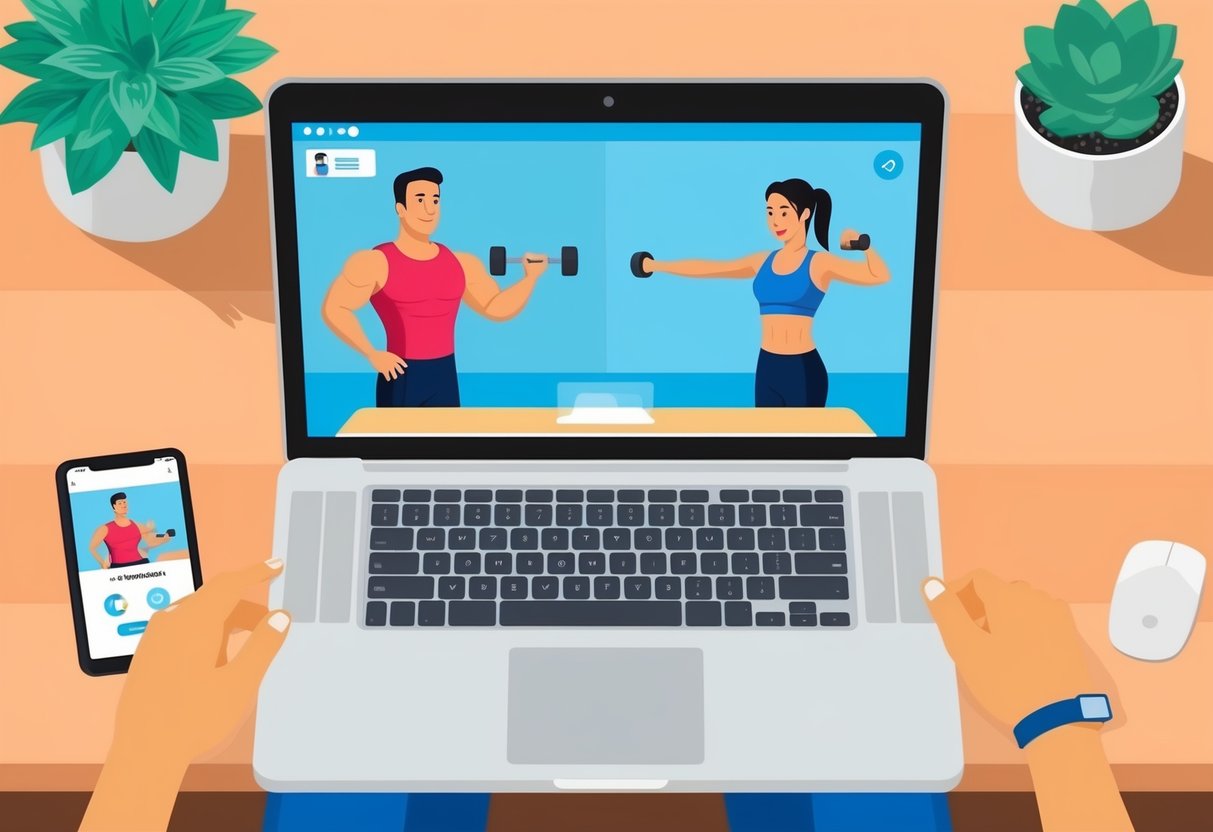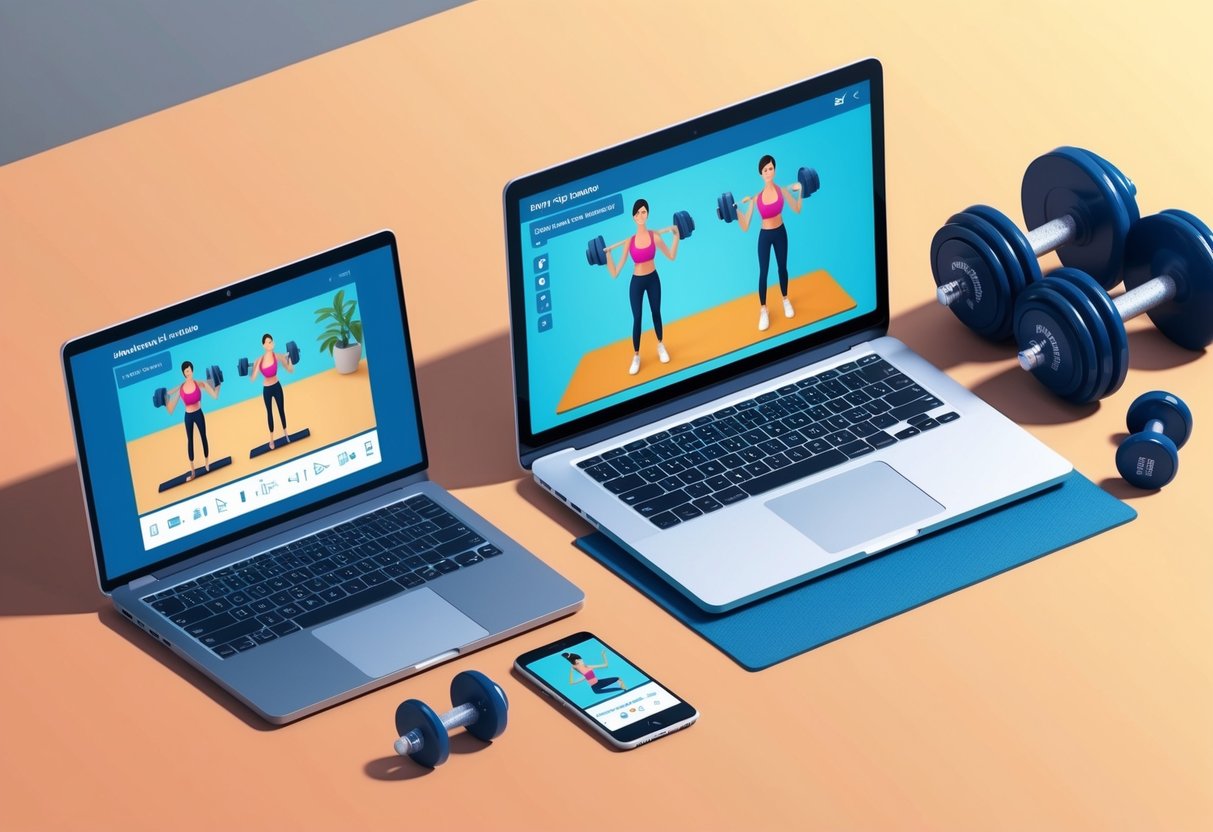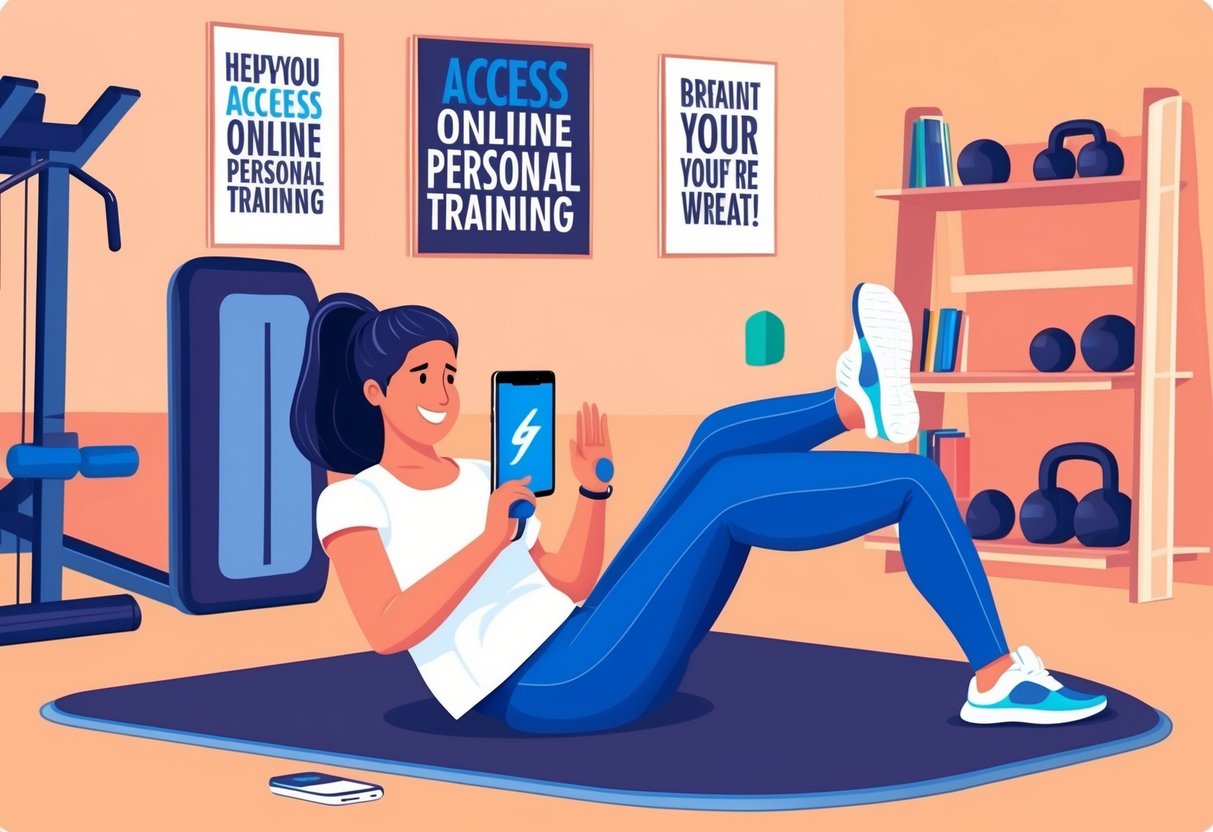Online personal training has revolutionized the fitness industry, offering convenience and flexibility to those seeking expert guidance. But, despite its growing popularity, misconceptions persist about its effectiveness and value.
Many people assume that virtual training lacks the personal touch of face-to-face interactions. In reality, online trainers use various communication tools to stay connected with clients, offering motivation and adjusting plans as needed.
This approach allows for consistent support and accountability, often surpassing the limited contact time of traditional gym sessions.
Advances in technology have expanded the range of exercises and equipment that can be incorporated into online training programs. From bodyweight workouts to specialized routines using home gym equipment, online trainers can design diverse and engaging workouts tailored to individual goals and preferences.
Key Takeaways
- Online personal training offers personalized programs and consistent support
- Technology enables diverse workout options and real-time feedback
- Virtual training can be as effective as in-person sessions for achieving fitness goals
Debunking Myth 1: Impersonal and Ineffective

Popular Posts
- Massage Gun vs. Foam Roller: Which Recovery Tool Reigns Supreme?
- 27 Best Calisthenics Exercises for Full-Body Strength and Fitness
- 10 HIIT Workouts for Busy Professionals: Max Fitness, Min Time
- Good Posture Working from Home: Optimize Your Workspace to Prevent Discomfort and Health Issues
- The Best Crossfit Exercises for Full-Body Conditioning
Online personal training offers personalized connections and effective results, contrary to common misconceptions. Technology enables trainers to provide tailored guidance and support remotely.
Establishing Personal Connections Online
Virtual platforms facilitate strong trainer-client relationships. Video calls allow face-to-face interactions, creating a personal touch.
Trainers use messaging apps for daily check-ins and feedback, fostering constant communication.
You’ll receive individualized attention through customized workout plans and nutrition advice. Your trainer will track your progress, adjusting programs as needed.
This level of personalization ensures your fitness goals remain the focus.
Regular virtual sessions help build rapport and trust. You’ll feel supported and motivated, just as you would with in-person training.
Effectiveness of Virtual Training
Online personal training delivers results when you commit to the process. Your trainer provides expert guidance tailored to your specific needs and available equipment.
Virtual sessions offer flexibility, allowing you to work out at convenient times and locations. This adaptability often leads to better adherence to fitness routines.
Trainers use video analysis to assess your form and technique, ensuring safe and effective workouts. They can demonstrate exercises and provide real-time corrections.
Digital tools track your progress, offering data-driven insights. This information helps your trainer optimize your program for maximum effectiveness.
Debunking Myth 2: One Size Fits All Approach

Online personal training offers tailored programs that adapt to individual needs and goals. Personalization and flexibility are key components of effective virtual fitness coaching.
Personalization of Online Training Programs
Online trainers create customized workout plans based on your specific goals, fitness level, and preferences. They consider factors like your available equipment, time constraints, and exercise history.
Your trainer may use questionnaires or video assessments to gather detailed information about your current abilities and limitations. This data helps them design a program that matches your needs.
Personalized plans often include variations of exercises to accommodate different fitness levels. For example, a beginner might start with bodyweight squats, while an advanced trainee could perform weighted jump squats.
Adaptation for Individual Needs
Online training programs evolve as you progress on your fitness journey. Your trainer monitors your performance and adjusts workouts accordingly.
They may increase intensity, modify exercises, or change the workout structure based on your feedback and results.
This ongoing adaptation ensures your program remains challenging and effective.
Your recovery needs are also considered. If you report excessive soreness or fatigue, your trainer can adjust the workout volume or incorporate more rest days.
Online trainers can modify plans for injuries or scheduling conflicts. They might suggest alternative exercises or provide shorter workouts when time is limited.
Debunking Myth 3: Limited Exercise Variety and Guidance
Online personal training offers diverse exercise options and expert guidance to help you achieve your fitness goals effectively. Let’s explore how virtual coaching provides exercise variety and proper form instruction.
Incorporating Diverse Exercise Modalities
Online trainers utilize a wide range of exercise modalities to keep your workouts engaging and effective. You can expect customized workout routines that blend strength training, flexibility work, and cardiovascular exercises.
Your virtual coach may incorporate bodyweight exercises, resistance band workouts, and equipment-based training to suit your preferences and available resources.
This variety helps target different muscle groups and prevents plateaus in your fitness progress.
Many online programs also integrate yoga, Pilates, or other specialized disciplines to enhance your overall fitness. You’ll have access to diverse workout styles that cater to your goals, whether you aim to build muscle, improve flexibility, or boost endurance.
Maintaining Proper Form and Technique
Online personal trainers prioritize teaching and reinforcing correct exercise form to maximize results and prevent injuries.
You’ll receive detailed video demonstrations and written instructions for each exercise in your program.
Your coach may request video submissions of your workouts to assess your form and provide personalized feedback.
This allows for real-time corrections and technique improvements, ensuring you perform exercises safely and effectively.
Many online training platforms offer live video sessions where you can receive immediate guidance on proper form.
These interactive sessions allow your trainer to observe your movements and offer instant corrections, just like in-person training.
Advanced technologies like AI-powered movement analysis are becoming more common in online training, providing additional form feedback and technique suggestions to complement your trainer’s expertise.
The Benefits of Online Personal Training
Online personal training offers advantages that make fitness goals more attainable. It combines flexibility with expert guidance to support your health journey.
Accessibility and Convenience
You can access your workouts anytime, anywhere. This flexibility allows you to fit exercise into your busy schedule without commuting to a gym.
Online trainers provide customized plans that adapt to your home environment or available equipment.
Your trainer is just a message away, offering quick responses to questions or form checks.
This constant support helps maintain your motivation and consistency. You can track your progress digitally, making it easier to see improvements over time.
Comprehensive Support for Fitness Goals
Online personal training covers all aspects of your fitness journey. Your trainer can create a balanced program that includes resistance training, cardio, and flexibility work.
This holistic approach supports your overall health and weight loss goals.
Trainers often provide nutritional guidance alongside workout plans. This combination helps you achieve better results.
You receive education on proper form and technique through video demonstrations and real-time feedback.
Online platforms often include communities of like-minded individuals. This social aspect can boost your motivation and provide extra support.
Your trainer can adjust your program as needed, ensuring you continue to progress and avoid plateaus.
Nutrition and Fitness: The Role of a Balanced Diet
A balanced diet plays a crucial role in achieving fitness goals and maximizing the benefits of personal training. Proper nutrition fuels workouts and supports recovery, working hand-in-hand with exercise for optimal results.
Integrating Diet Into Personal Training
Your online personal trainer can help you create a tailored nutrition plan alongside your workout routine.
They’ll assess your current eating habits and recommend adjustments to support your fitness objectives. This may include tracking macronutrients, suggesting meal timing around workouts, and advising on portion sizes.
A balanced diet for fitness typically includes:
- Lean proteins for muscle repair and growth
- Complex carbohydrates for energy
- Healthy fats for hormone production
- Fruits and vegetables for vitamins and minerals
Your trainer might also guide you on proper hydration and the strategic use of protein shakes to supplement your diet when needed.
Myths Around Diet and Exercise
Many misconceptions exist about nutrition and fitness. Here are some common myths debunked:
- Myth: You must eat immediately after exercise.
Fact: While post-workout nutrition is important, you have a wider window than just 30 minutes to refuel. - Myth: Protein shakes are essential for muscle gain.
Fact: Whole food sources can provide adequate protein for most people. - Myth: Carbs are bad for weight loss.
Fact: Carbohydrates are an important energy source and can be part of a balanced weight loss diet.
Supporting Tools for Online Personal Training
Online personal training utilizes various digital tools and technologies to deliver effective workouts remotely. These tools enhance the training experience and help clients achieve their fitness goals from home.
Leveraging Technology for Enhanced Training
Video conferencing platforms enable face-to-face interactions between trainers and clients. These tools allow trainers to demonstrate exercises, provide real-time feedback, and monitor form.
Fitness apps and wearable devices track progress, log workouts, and measure vital statistics. This data helps trainers adjust workout plans and keep clients accountable.
Custom workout plan software lets trainers create personalized programs tailored to each client’s needs and goals. These digital plans can be easily shared and updated as needed.
Equipment and Space Utilization
Resistance bands, dumbbells, and bodyweight exercises form the foundation of many virtual training sessions. These versatile tools require minimal space and are cost-effective alternatives to gym equipment.
Trainers often recommend specific equipment based on your fitness level and available space. This might include yoga mats, stability balls, or adjustable dumbbells for a compact home gym setup.
Virtual reality and augmented reality technologies are emerging as innovative tools for immersive workout experiences. These technologies can simulate gym environments and provide interactive training sessions in your living room.
Success Stories: Transformations and Testimonials
Online personal training has produced remarkable results for clients of all fitness levels. The following examples showcase how virtual coaching can lead to real-world transformations.
Real-life Examples of Online Training Efficacy
Sarah, a busy mom, lost 30 pounds in 6 months through online coaching. Her trainer provided customized workouts and nutrition plans that fit her schedule.
Mark, an office worker, gained 15 pounds of muscle mass in 4 months. Virtual sessions helped him perfect his form and progressively increase weights.
Elite athlete Jessica improved her marathon time by 15 minutes. Her online coach analyzed her running data and tailored her training program accordingly.
Tom, recovering from a knee injury, regained full mobility within 3 months. His trainer guided him through rehabilitation exercises via video calls.
Addressing Concerns with Evidence of Success
A study of 500 online training clients showed 87% achieved their fitness goals within 6 months. This success rate matches or exceeds that of in-person training.
Client surveys reveal high satisfaction rates. 92% of participants reported feeling more confident in their ability to maintain their fitness routines.
Injury prevention success is notable. Among clients who followed their online programs closely, injury rates were 40% lower than the general gym-going population.
Long-term results are promising. 78% of clients maintained their weight loss or muscle gain for at least one year after completing their online training programs.
Frequently Asked Questions
Online personal training has gained popularity, but many potential clients still have questions about its effectiveness and implementation. Let’s address some common inquiries.
What are the potential drawbacks of not having in-person supervision in online personal training?
Without in-person supervision, form correction can be more challenging. You might not receive immediate feedback on your exercise technique. There’s also a higher risk of injury if you don’t follow instructions carefully.
How does the effectiveness of online personal training compare to traditional gym-based training?
Online personal training can be just as effective as gym-based training when done correctly. You have more flexibility in scheduling and location. Results depend on your commitment and following the program consistently.
Is remote communication with an online personal trainer sufficient for monitoring progress?
Remote communication can be highly effective for progress monitoring. You can send videos of your workouts, track measurements, and discuss challenges. Regular check-ins help maintain accountability and allow for program adjustments.
What are the qualifications of online personal trainers, and how are they verified?
Online personal trainers should hold recognized certifications from accredited organizations. You can verify their credentials by checking certification databases or requesting proof directly from the trainer.
How do online personal training programs address individual fitness levels and specific goals?
Online trainers create customized programs based on your fitness assessment, goals, and available equipment. They adjust workouts as you progress and provide modifications for different fitness levels.
Can online personal training provide personalized workout and diet plans?
Yes, online personal trainers can create tailored workout and nutrition plans. They consider your preferences, dietary restrictions, and lifestyle factors.
Then, they design a sustainable approach to fitness and nutrition.






